How to Pick Side Stone Diamonds?
What Are Side Stone Diamonds?
Side Stone Diamonds are (most commonly) smaller matching diamonds placed with the goal of accenting, or enhancing the appeal of a larger center stone. In order to accomplish their intended goal, there’s quite a few factors to consider such as the proper ratio compared to the main piece, as well as the color and clarity. They are used in a variety of designs, but the following are their most sought after implementations:
Three Stone Engagement Rings

Three Stone Diamond Ring Designs are not just visually stunning, but hold a great deal of romantic meaning. They are often said to symbolize the past, present, and lastly, the future, something soon to be married couples can definitely relate to. representing the Past, Present, and Future.
From a design point of view, more often than not you will see medium-sized stones in a variety of supporting shapes on each opposing side of a large center stone diamond. In some cases, however, all three stones are similar change.
When done correctly, the concept of three stone diamonds brings a lot of benefits to those wearing them. From bringing more attention and increasing the natural qualities the center stone diamond has, to offering a chance for creative combinations, and in certain cases, even different colors.
Five Stone Engagement Rings
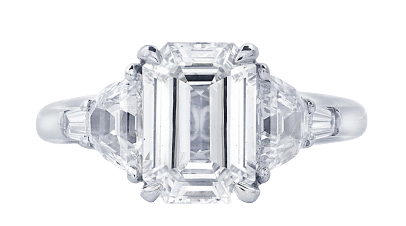
Five Stone Diamond Engagement Rings are another popular and highly symbolic design style that incorporates side stones in a statement piece. The smaller stones are situated on the outside, with slightly larger ones on the opposing sides o the larger center stone, which creates an elegant and stunning end result. Five Stone Diamond Engagement Rings can also be seen combined with colored diamonds or gemstones, or of course, the classic diamond only variation.
Five stones have different symbolism attached to it, from those believing it represents five years of marriage, while others look at it as a symbol of their own story, beginning with friendship, courtship, dating one another, marriage, and finally, starting a family and having children.
Cathedral Diamond Engagement Rings
Cathedral Engagement Rings are another popular ring design style that often incorporates side stones. Its name comes from its subtle yet captivating design which thanks to its arches resembles the shape of cathedral buildings. While they are available with the minimalist approach where the focus is solely on the center stone and the band surrounding it, another popular variation is getting the best of both worlds, which involves settings a row, or multiple rows of small side stone diamonds accenting the main piece.
What Shapes are Used as Sidestones?
The short answer is that nearly any diamond can be used as a side stone, it all depends on styles that appeal to you most. Going with the classics is considered the safest bet and more of a conventional approach, but the options are limitless. Classic combinations in side stone diamonds are all about the method of cutting, for example, An Asscher Cut as the center stone, which is a step cut is popularly matched with Step Cut Trapezoid Diamonds.
A Three Stone Engagement Ring which has a Brilliant Round Cut Diamond at its center is often combined with smaller round cuts, or other Brilliant Cut shapes such as pears, and oval-shaped diamonds, among others. Modern options don’t adhere to such rules, they are more trend-based, and are marketed in cycles between one another. That is not to say that there aren’t stunning options that come with the modern approach, but just a good thing to know in advance.
A great example of an ongoing trend is combining a Three Stone Engagement Ring with a Brilliant Round Cut Diamond as the center stone, with two matching baguette side stones situated horizontally and its opposing sides.
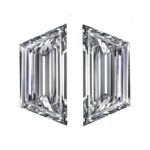
Trapezoid Cut Side Stone Diamonds
Despite being relatively new in the diamond industry, the Trapezoid Diamond in both Brilliant and Step Cut variations have truly established itself as one of the greats. Perhaps most notable is its implementation in Three Stone Engagement Rings, where its noticeably large surface area has the desirable effect of creating a larger, more whole appearance to the overall ring. You will often find Trapezoids matched with Rectangular and Square Shaped Diamonds.
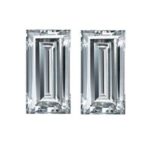
Baguette/Tapered Baguette Cut Side Stone Diamonds
The Baguette Cut is a highly popular and viable option to incorporate as side stones, for those that are after sophistication and elegance and want to separate themselves from the pack. Where they differ from shapes like the previously mentioned Trapezoid Stone Diamond is that they are more versatile in their ability to blend naturally with almost all possible center diamond shapes.
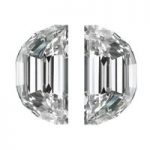
Half Moon Cut Diamond Side Stones
The Half Moon Cut, which used to exclusively be manufactured as step cut, had expanded to include both the step cut and brilliant cut variations in recent years due to its tremendous success. It is near unrivaled when it comes to naturally bringing more attention and a sense of enclosure to the center stone, while making its inherent qualities come even more into view. They are also quite cost-effective, and a lot more flexible when it comes to their characteristics matching well with the center stone.
You will often see half moon side stone diamonds combined with Rectangular shaped diamonds like Radiant, Princess & Emeralds. The half moon cut due to its curved corners can also work tremendously well by providing a sense of encirclement with rounded shapes like the Oval, and Round Cut.
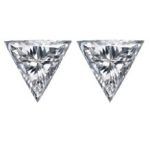
Trilliant Cut Side Stone Diamonds
The Trilliant Shaped Diamond, which also goes by the name of Trillion, is a sophisticated and a stunning pairing option for side stone use, with a gorgeous light display while maintaining a fresh look that takes a step back from your everyday diamond piece. Since they are cut relatively shallow but have an above-average width, they also appear larger than their weight would indicate, making them quite cost-effective. They work quite well with a large variety of center stones, from the classic Round Cut, Princess, Radiants, and endless other possibilities.

Bullet Cut Side Stone Diamonds
Bullet Cut Side Stone Diamonds are a hot item in the field of side stones, and as indicated by their name, look similar to bullets. The truth of the matter is that bullets are an intelligent modification of the classic baguette, both straight and tapered, with a narrower v shape bottom. For the most part, they are four-sided, with three sides being equal, while the last has a sharpened edge which goes incredibly well is positioned seamlessly in diamond settings.
Bullet Cuts are primarily of the step cut method, with some rare exceptions. Straight Bullets are the cleaner geometric ones in the bunch, but their tapered version gives them a little more of an antique look which is quite popular nowadays. Combining the Step Cut Bullets as Side Stones works incredibly well with Emeralds as the center stone in three-stone engagement rings.
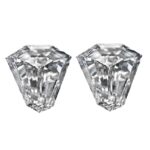
Shield Shaped Side Stone Diamonds
Shield Cut Diamonds are a family of cuts in their own right, triangular in nature, with the classic ones bearing the symbolism and proportions of shields used by warriors in the past. Shields more often than not have tapered corners, bowed top, and a V-shaped bottom section which gives them their stunning visuals. There are also unique shield variations from the superman shield, to the elongated shield which extends the classic form and is highly sought after, often used for dangle earrings, necklaces, and pendants. Shields are available in both brilliant, as well as step cuts, but Step Cut Shields are more popular. Due to their nature, shields are versatile and work seamlessly with any center stone provided it belongs to the same family of cuts.
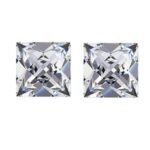
French Cut Side Stone Diamonds
French Cut Diamonds are the predecessors to many modern cuts we know and love today, dating back to the 14th century. Their popularity grew during the height of the art deco movement due to a distinctive look that is largely attributed to their high crown position, and four triangular facets (the total facets are between 18 to 24), and an overall rhombus type tables look. In fact, the French Cut Diamond is often the key player, acting as a center stone in many art deco inspired diamond engagement rings.
Some of the best combos however, are combining the French Cut Diamonds as Side Stones with An Oval, Round, or Princess as the center stone, in Three Stone, or Five Stone Engagement Rings.
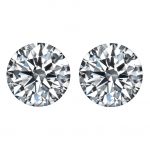
Brilliant Round Cut Side Stone Diamonds
The classic Brilliant Round Cut is both an incredible center stone and viable option as side stones, in cases such as three stone and five stone engagement rings, among others. You can see it incorporated in some fascinating combinations, such as being placed on the opposing sides of a stunning marquise cut center stone diamond, or supporting a larger center stone, oval, or pear shaped cuts, among others.
The Ultimate Side Stone Combination Chart
Below you will find the most complete side stone combination to center stone matching in the world, created by us. No longer will you have to do guess work if one of your unique combinations that you haven’t seen examples of would look good or make sense together. The chart includes 25 different side stones which create 250 different combinations for you to explore. Want to visualize a pear center stone with tapered bullets? A Princess with Epaulettes? feel free to explore all the possibilities in your mind or get inspired for your planned three stone engagement ring.
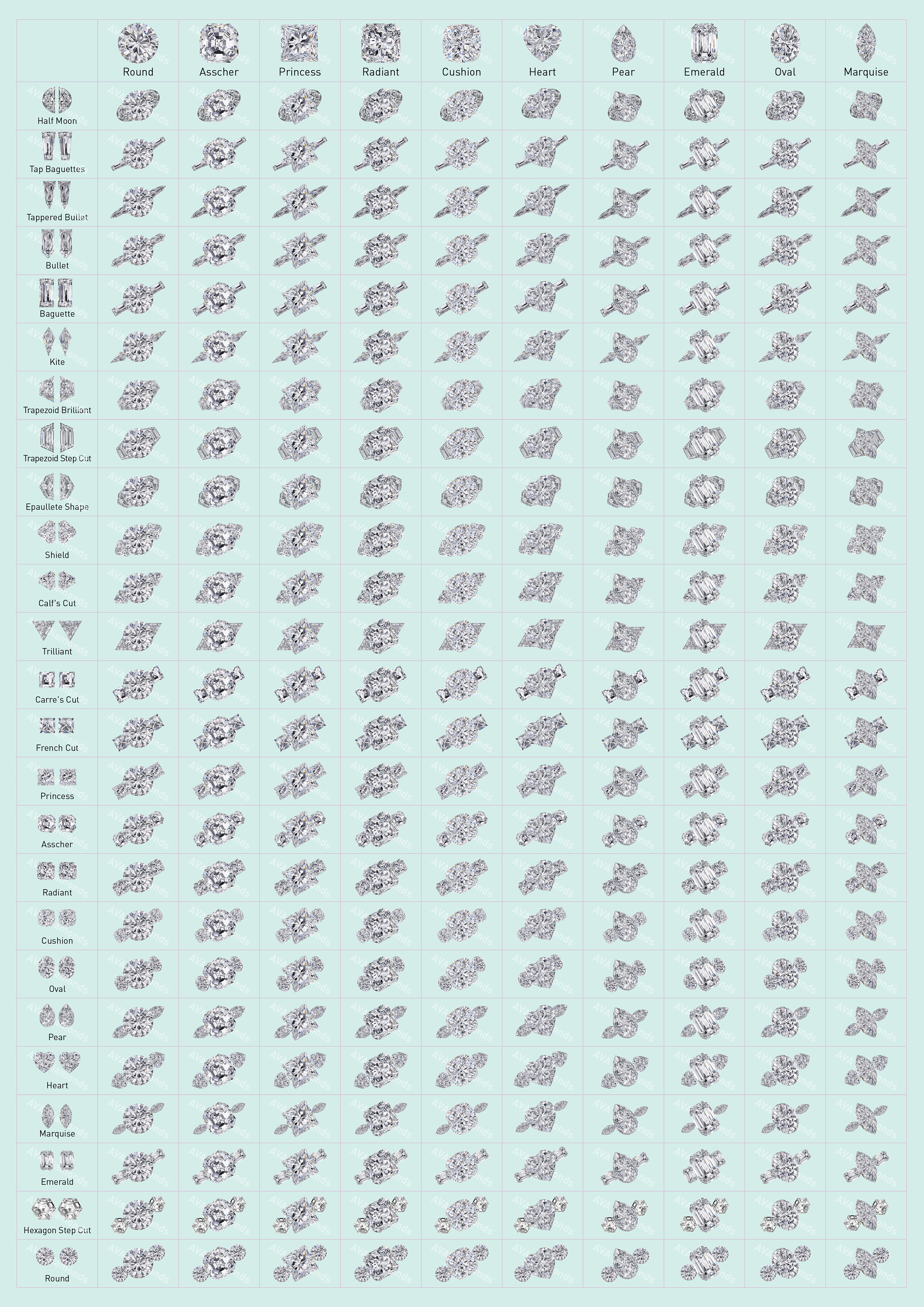
How Many Side Stones Should I Choose?
The amount of side stones to go for is one of the first and most important decisions to make in the overall design of your engagement ring. The most common choice is undoubtedly a Three Stone Engagement Ring design, which will mean choosing two side stones. The second most popular option nowadays is to opt for a five stone engagement ring which as the name suggests would entail two side stones on each opposing side. The truth of the matter is there is no limit to how many side stone diamonds you can surround your center stone with, but it’s important to note that the more side stones you incorporate, the more difficult it will be to achieve your intended goal, as each diamond piece, however small, will require a separate ring setting. That is not to say that more than five stone diamonds can’t work, but it does entail more potentially costly repairs in the future.
What Size Should Side Stones Be?
There are a number of factors that give side stones their desired effect. Proper size implementation is undoubtedly one of the most important ones. Three Stone Engagement Ring Side Stone Size Formula: As the most popular and time-proven combination, three stone engagement rings follow a minimum and maximum formula depending on personal preferences. The intended goal is to have side stones that aren’t big enough to take attention away from the main piece, but not too small as to not enhance it at all.
The general rule is between a minimum of half (50%), to two thirds the (65%) of the size of the center diamond. If you want to calculate with a higher degree of accuracy to consider a particular piece, you need to divide the average diameter If you opt for more than two side stones, it is a general rule that they should be quite noticeably smaller. If you choose the classic two side stones, one on each opposing sides of the center piece, slightly smaller will suffice.
How to Choose the Right Color for Side Stone Diamonds?
There are two major factors in choosing the ideal color for your side stone pieces. The side stone colors need to match one another completely, or as close to one another as possible. The color of your side stones should be a grade lower than the color of your center stone diamond, but not more. They most certainly should not be higher in their color grade than your center stone, as that would ruin their intended goal of enhancing its qualities. A G Color Princess Cut for example, should have H color side stone diamonds accompany it.
What's the Best Clarity for Side Stones?
It is always important to begin with the basics when it comes to clarity in side stone diamonds. Look for side stones with clarity that is eye clean. What do we mean when we say eye clean? diamonds that have inclusions and various imperfections that are not visible to the naked eye. That is not to say that you have to opt for non economical clarity choices. In fact, depending on the ring settings used, and the positioning of the inclusions, you can save a substantial amount of money while hiding these imperfections. The clarity between each individual side stone should be as identical as possible, and no more than a grade lower from one another.
What are the Best Ring Settings for Side Stone Diamonds?
Choosing the right settings for your side stone diamond ring is one of the most important decisions to make, as side stone diamonds can loosen over time if you opt for a setting that is not suitable to protecting and maintaining them. The safest choice is undoubtedly going the most classic route which is using the classic prong settings. Why? Because they’re the perfect blend of securing stones, and enhancing their brilliance instead of diminishing it. They work by extending a metal extending from the bottom, then curved in a subtle way over each stone. There are dozens of variations of prong settings, meaning you don’t have to settle for one style only.
Other popular choices include Bezel and Cathedral Settings.
